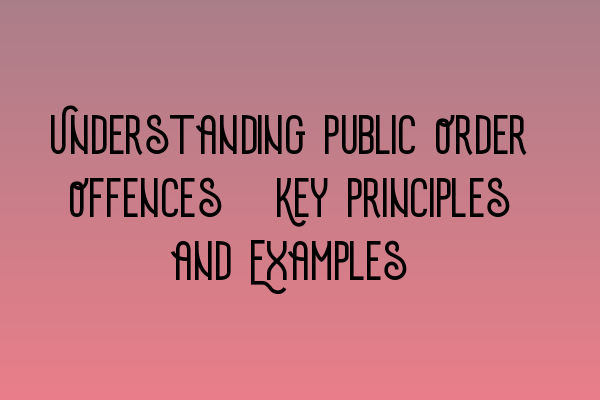Understanding Public Order Offences: Key Principles and Examples
Public order offences are a category of criminal offences that involve actions or behaviors that disturb the public peace, safety, or order. These offences can range from minor disruptions to serious incidents of violence in public spaces. Understanding the key principles and examples of public order offences is essential for both legal professionals and individuals who want to be aware of their rights and responsibilities in society.
Key Principles
Public order offences are governed by various laws and statutes, which outline the principles that guide their interpretation and enforcement. Some key principles to understand include:
- Preservation of Public Order: Public order offences exist to ensure the maintenance of public peace, safety, and order.
- Subjective and Objective Test: Public order offences often require the prosecution to prove both a subjective element (intent or knowledge) and an objective element (the effect on public order).
- Proportionality: The punishment for public order offences should be proportionate to the gravity of the offense and the harm caused.
- Freedom of Expression: Public order offences should not unduly restrict individuals’ rights to freedom of expression, assembly, and protest.
By understanding these principles, legal professionals can navigate the complexities of public order offences and provide the best possible advice and representation to their clients.
Examples of Public Order Offences
Public order offences encompass a wide range of behaviors and actions. Here are some examples of common public order offences:
- Public Disturbance: This offence involves engaging in disorderly conduct or behavior in a public place that disrupts public order.
- Rioting: The act of participating in a violent public disturbance involving a large group of people.
- Unlawful Assembly: Gatherings or demonstrations that have not been authorized by the relevant authorities, often leading to public disorder.
- Incitement to Violence: Encouraging others to engage in violence or disorderly conduct in a public setting.
- Breach of the Peace: Behaviors that cause fear, alarm, or distress to others and disturb public order.
These are just a few examples of public order offences, and the specific laws and penalties associated with each offence may vary depending on the jurisdiction.
If you are studying for the SQE 1 or SQE 2 exams, it is important to have a comprehensive understanding of public order offences and their legal implications. Make sure to check out our related articles for further preparation:
- SQE 1 Practice Exam Questions
- SQE 1 Practice Mocks FLK1 FLK2
- SQE 2 Preparation Courses
- SQE 1 Preparation Courses
- SRA SQE Exam Dates
These resources will provide you with invaluable practice and insights to enhance your knowledge and boost your chances of success in the SQE examinations.
In conclusion, understanding public order offences is crucial for legal professionals and individuals alike. By grasping the key principles and familiarizing ourselves with the examples, we can ensure a fair and just society where public peace and order are maintained. Stay informed, prepare diligently, and be well-equipped to navigate the intricacies of public order offences.
